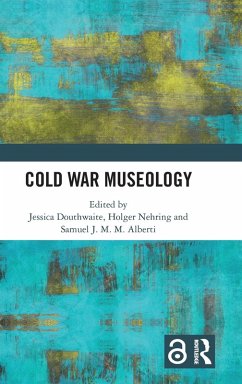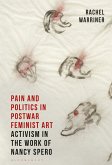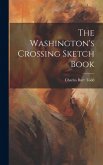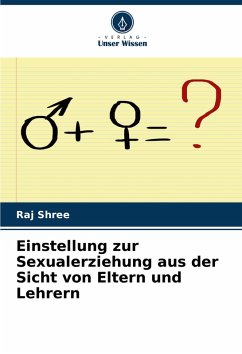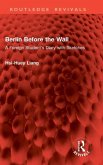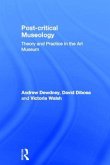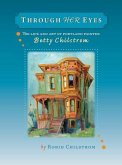Cold War Museology
Herausgeber: Douthwaite, Jessica; J M M Alberti, Samuel; Nehring, Holger
Cold War Museology
Herausgeber: Douthwaite, Jessica; J M M Alberti, Samuel; Nehring, Holger
- Gebundenes Buch
- Merkliste
- Auf die Merkliste
- Bewerten Bewerten
- Teilen
- Produkt teilen
- Produkterinnerung
- Produkterinnerung
Cold War Museology is the first volume to bring together interdisciplinary and international contributions from leading practitioners and academics specialising in Cold War museology.
Andere Kunden interessierten sich auch für
![Pain and Politics in Postwar Feminist Art Pain and Politics in Postwar Feminist Art]() Rachel WarrinerPain and Politics in Postwar Feminist Art131,99 €
Rachel WarrinerPain and Politics in Postwar Feminist Art131,99 €![The Washington's Crossing Sketch Book The Washington's Crossing Sketch Book]() Charles Burr ToddThe Washington's Crossing Sketch Book28,99 €
Charles Burr ToddThe Washington's Crossing Sketch Book28,99 €![Cosmopolitan Ambassadors Cosmopolitan Ambassadors]() Lee DavidsonCosmopolitan Ambassadors76,99 €
Lee DavidsonCosmopolitan Ambassadors76,99 €![Saving Spaces Saving Spaces]() John H Sprinkle JrSaving Spaces157,99 €
John H Sprinkle JrSaving Spaces157,99 €![Berlin Before the Wall Berlin Before the Wall]() Hsi-Huey LiangBerlin Before the Wall114,99 €
Hsi-Huey LiangBerlin Before the Wall114,99 €![Post Critical Museology Post Critical Museology]() Andrew DewdneyPost Critical Museology180,99 €
Andrew DewdneyPost Critical Museology180,99 €![Through Her Eyes Through Her Eyes]() Robin ChilstromThrough Her Eyes38,99 €
Robin ChilstromThrough Her Eyes38,99 €-
-
-
Cold War Museology is the first volume to bring together interdisciplinary and international contributions from leading practitioners and academics specialising in Cold War museology.
Produktdetails
- Produktdetails
- Verlag: Taylor & Francis
- Seitenzahl: 276
- Erscheinungstermin: 27. November 2024
- Englisch
- Abmessung: 234mm x 156mm x 18mm
- Gewicht: 585g
- ISBN-13: 9781032690407
- ISBN-10: 1032690402
- Artikelnr.: 71234272
- Herstellerkennzeichnung
- Libri GmbH
- Europaallee 1
- 36244 Bad Hersfeld
- gpsr@libri.de
- Verlag: Taylor & Francis
- Seitenzahl: 276
- Erscheinungstermin: 27. November 2024
- Englisch
- Abmessung: 234mm x 156mm x 18mm
- Gewicht: 585g
- ISBN-13: 9781032690407
- ISBN-10: 1032690402
- Artikelnr.: 71234272
- Herstellerkennzeichnung
- Libri GmbH
- Europaallee 1
- 36244 Bad Hersfeld
- gpsr@libri.de
Jessica Douthwaite is a Postdoctoral Research Fellow at the University of Stirling working on the AHRC-funded collaboration with National Museums Scotland, Materialising the Cold War. Her Collaborative Doctoral Partnership PhD based at IWM London and University of Strathclyde was titled "Voices of the Cold War in Britain, 1945-1962" and awarded in 2018. She is currently writing a monograph which explores how the national and international landscapes of post-war Britain contextualised and influenced civilian experiences of Cold War security. She specialises in museum studies, ethnographic and interview methodology, and gender and international histories. Holger Nehring is Professor of Contemporary European History at the University of Stirling. He has published widely on the history of social movements in a transnational and global context as well as on the conceptual history of the Cold War. Together with Sam Alberti, he is the Co-I for the AHRC-funded project 'Materialising the Cold War'. Samuel J.M.M. Alberti is Director of Collections at National Museums Scotland, and an Honorary Professor in Heritage Studies at the University of Stirling. After training in history of science and teaching museology he worked at the intersection of museums and universities, first at the Manchester Museum, then as Director of Museums and Archives at the Royal College of Surgeons of England (including the Hunterian Museum). With Holger Nehring he led the AHRC-funded research project, 'Materialising the Cold War'.
1. Making and unmaking the Cold War in museums; Section One: Networks of
materiality; 2. Readiness for Red Alert: Engaging with the Material Culture
of the Royal Observer Corps; 3. Anchoring museum objects in the Cold War:
The hidden meanings of a Transatlantic telephone cable; 4. Beyond
Janus-faced narratives: object lessons from the travelling-wave maser; 5.
The Vulcan's voice: Multiple meanings of a Cold War artefact; Section Two:
Spaces, places and things; 6. Cold War through the looking glass: Espionage
objects, authenticity and multiperspectivity; 7. Bunkers Revisited:
Co-producing Memory, Meaning and Materiality in Danish Cold War Museums; 8.
Creating a new Cold War museum: Curatorial reflections; 9. A War That Never
Was: Locating, collecting, and exhibiting the experiences of British forces
in Cold War West Germany; 10. There can't be any Berlin Wall left: oral
history, 'domestic museums' and the search for a British Cold War; 11.
Looking out from Point Alpha: Entangled histories in a Cold War borderland;
Section Three: Values and representations; 12. Cold War time: Contemporary
military heritage in Sweden; 13. How the U-2 became a museum object - local
identities and museum collections at the Norwegian Aviation Museum in Bodø;
14. Competing for authenticity, nostalgia, and visitor revenue in Cold War
Museum; 15. What Colour was the Cold War?
materiality; 2. Readiness for Red Alert: Engaging with the Material Culture
of the Royal Observer Corps; 3. Anchoring museum objects in the Cold War:
The hidden meanings of a Transatlantic telephone cable; 4. Beyond
Janus-faced narratives: object lessons from the travelling-wave maser; 5.
The Vulcan's voice: Multiple meanings of a Cold War artefact; Section Two:
Spaces, places and things; 6. Cold War through the looking glass: Espionage
objects, authenticity and multiperspectivity; 7. Bunkers Revisited:
Co-producing Memory, Meaning and Materiality in Danish Cold War Museums; 8.
Creating a new Cold War museum: Curatorial reflections; 9. A War That Never
Was: Locating, collecting, and exhibiting the experiences of British forces
in Cold War West Germany; 10. There can't be any Berlin Wall left: oral
history, 'domestic museums' and the search for a British Cold War; 11.
Looking out from Point Alpha: Entangled histories in a Cold War borderland;
Section Three: Values and representations; 12. Cold War time: Contemporary
military heritage in Sweden; 13. How the U-2 became a museum object - local
identities and museum collections at the Norwegian Aviation Museum in Bodø;
14. Competing for authenticity, nostalgia, and visitor revenue in Cold War
Museum; 15. What Colour was the Cold War?
1. Making and unmaking the Cold War in museums; Section One: Networks of
materiality; 2. Readiness for Red Alert: Engaging with the Material Culture
of the Royal Observer Corps; 3. Anchoring museum objects in the Cold War:
The hidden meanings of a Transatlantic telephone cable; 4. Beyond
Janus-faced narratives: object lessons from the travelling-wave maser; 5.
The Vulcan's voice: Multiple meanings of a Cold War artefact; Section Two:
Spaces, places and things; 6. Cold War through the looking glass: Espionage
objects, authenticity and multiperspectivity; 7. Bunkers Revisited:
Co-producing Memory, Meaning and Materiality in Danish Cold War Museums; 8.
Creating a new Cold War museum: Curatorial reflections; 9. A War That Never
Was: Locating, collecting, and exhibiting the experiences of British forces
in Cold War West Germany; 10. There can't be any Berlin Wall left: oral
history, 'domestic museums' and the search for a British Cold War; 11.
Looking out from Point Alpha: Entangled histories in a Cold War borderland;
Section Three: Values and representations; 12. Cold War time: Contemporary
military heritage in Sweden; 13. How the U-2 became a museum object - local
identities and museum collections at the Norwegian Aviation Museum in Bodø;
14. Competing for authenticity, nostalgia, and visitor revenue in Cold War
Museum; 15. What Colour was the Cold War?
materiality; 2. Readiness for Red Alert: Engaging with the Material Culture
of the Royal Observer Corps; 3. Anchoring museum objects in the Cold War:
The hidden meanings of a Transatlantic telephone cable; 4. Beyond
Janus-faced narratives: object lessons from the travelling-wave maser; 5.
The Vulcan's voice: Multiple meanings of a Cold War artefact; Section Two:
Spaces, places and things; 6. Cold War through the looking glass: Espionage
objects, authenticity and multiperspectivity; 7. Bunkers Revisited:
Co-producing Memory, Meaning and Materiality in Danish Cold War Museums; 8.
Creating a new Cold War museum: Curatorial reflections; 9. A War That Never
Was: Locating, collecting, and exhibiting the experiences of British forces
in Cold War West Germany; 10. There can't be any Berlin Wall left: oral
history, 'domestic museums' and the search for a British Cold War; 11.
Looking out from Point Alpha: Entangled histories in a Cold War borderland;
Section Three: Values and representations; 12. Cold War time: Contemporary
military heritage in Sweden; 13. How the U-2 became a museum object - local
identities and museum collections at the Norwegian Aviation Museum in Bodø;
14. Competing for authenticity, nostalgia, and visitor revenue in Cold War
Museum; 15. What Colour was the Cold War?

